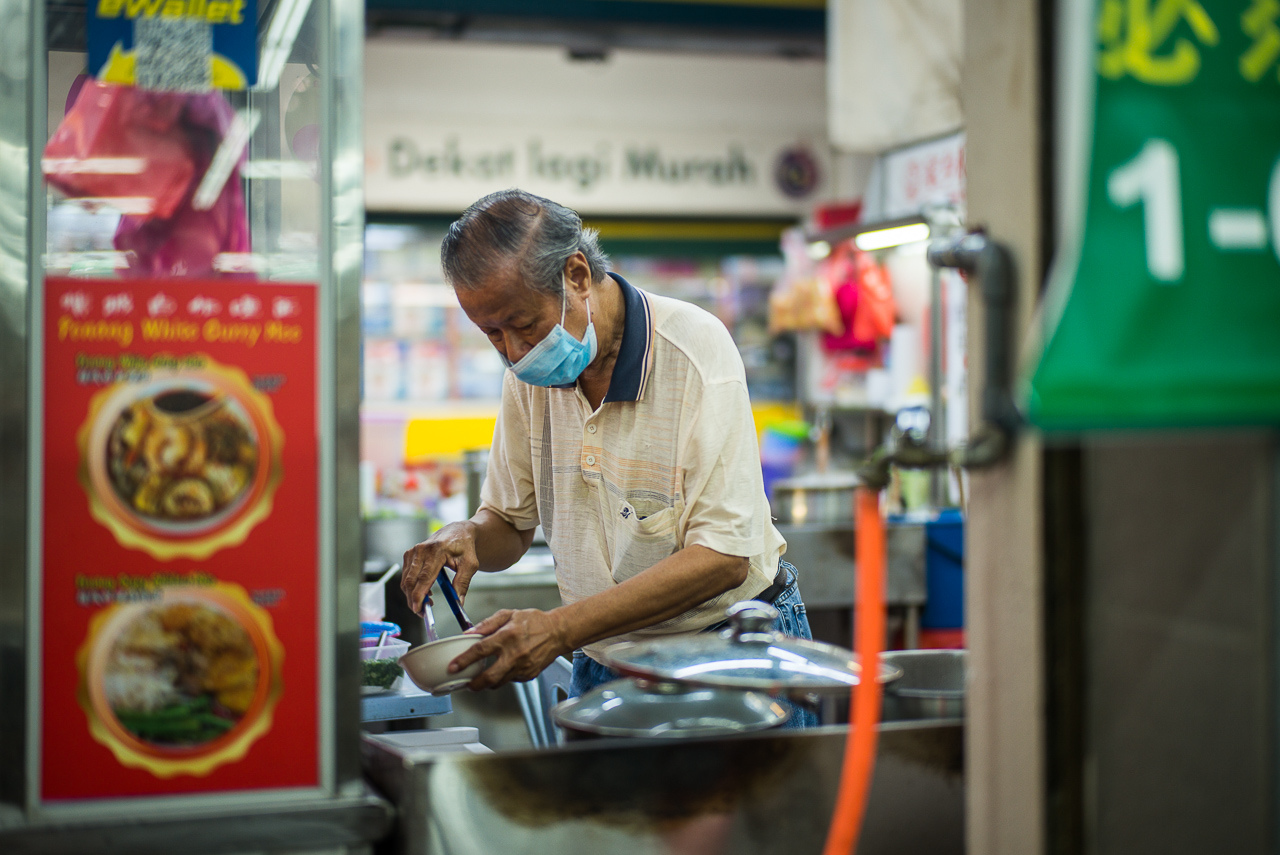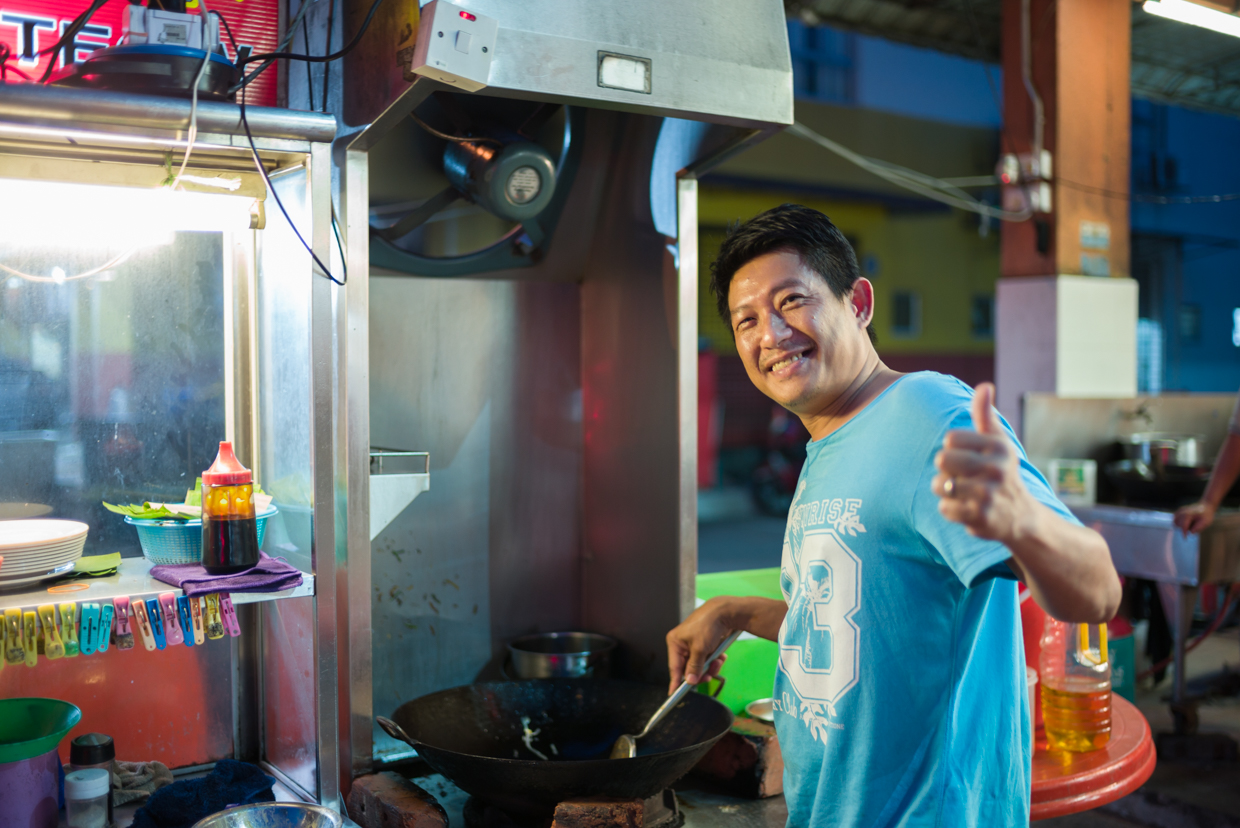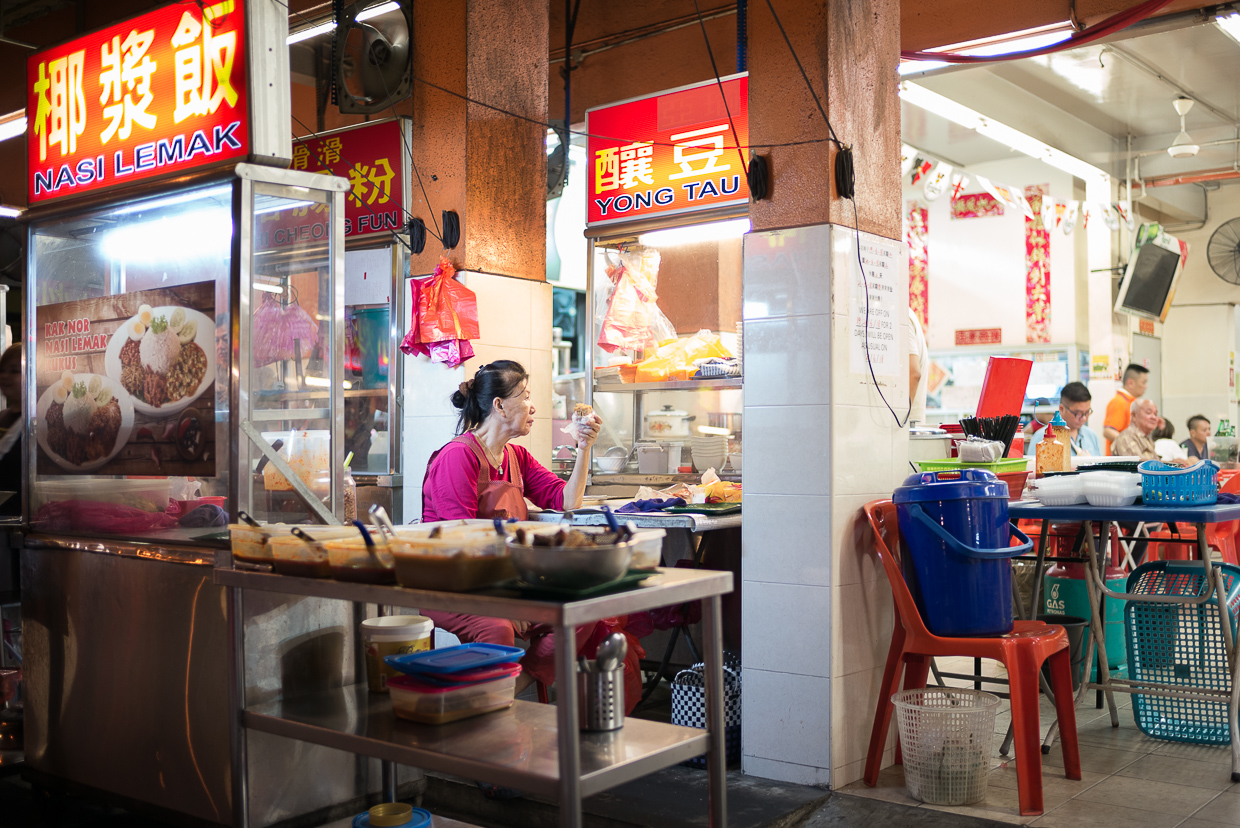
Food courts
In a local food court, where we discovered a Thai food stall with a cook who knew what he was doing (not the one in the photo). What surprised me a bit was the age of this man cooking... usually they're a lot younger in these places...
...
Malaysia is renowned for its food culture. I love to observe culture, I mean, what else is there, but I'm a difficult eater. A bit like a toddler I suppose, with not much appetite for vegetables and a lot of 'no' on stuff you find in Asian cooking (for instance, I can't stand sesame seed - don't ask me why - and some of the cooking here is done with sesame oil... I really can't stand the smell... same for oyster-sauce...). I'm also no fan of pork (not for religious reasons, I just don't care for the fatty taste), and I prefer to skip over beef if it's not a lean steak or a burger. Which leaves me mainly with chicken and sea food. Quite sufficient by the way, but not easy for me or the people who invite me to dinner.
In Malaysia you will never starve. There's food stalls, fruit stalls and restaurants on every street corner, even in the smallest or remotest towns and areas. Food is abundant and in the local places usually very affordable. I'm writing 'affordable' with the local economy in mind, because to a westerner with his or her much stronger dollars or euros, almost everything is cheap here. Eating a whole meal for 4 euros is practically unheard of in the west.
However, and with the risk of offending Malaysians: the food is not all good. The problem seems to be that everyone thinks they can cook. They can't. The second problem is that some cheap skate restaurant owners go for the lowest priced goods, ending up with dry tasteless rice, smelly rice, poorly tasting vegetables, cheap smelly cooking oil and dried out chicken that's too old.
For me personally the rice always gives it away: if the rice is good, the battle is already half won.
Of course, your average Malaysian is no food critic (or a whining toddler like me). So these places usually still thrive, because they're cheap. Which basically makes it impossible to assess quality just by looking at the occupancy of a restaurant; occupancy means nothing in the more local ones.
So, if you do try the food courts or the more local restaurants, you also need a bit of luck or a somewhat critical local who can guide you around and who knows the better places. If it's a food court (that's usually lots of food stalls in an inside place with tables partially outside) you won't be served. You go in, pick a stall, pick a meal and they will bring it to your table (then you pay) or you wait around for it.

Cook at food court happy to pose....
The drinks are ordered separately (usually someone will come to your table) and paid separately upon delivery. Of course there are also local restaurants, where they do serve and take orders at the table. Usually a little bit more expensive.
For a foreigner or tourist, not used to this abundant food culture, these places aren't easy to navigate. The food courts are organized chaos, noisy and around dinner time very busy. There's also a big chance none of the people who need to help you speak English, especially if you're outside the bigger cities.
There's not just these cheaper places; there's a whole range of restaurants, going from affordable to quite expensive. For a more western dinner experience you can pick the more 'classy' restaurants that are around (mainly in the bigger cities or in the shopping malls).
So what about hygiene? Since I have no control over it I usually don't bother: every bite an adventure! But seriously, this might be a bit of an exaggerated topic at western dinner tables... because on all my travels, in and out of Malaysia and the countries surrounding it, for 16 years now, I had food poisoning only twice. Once in Malaysia and once in Cambodia (where I only spent 5 days - not a good score). The one in Cambodia was from quite an expensive restaurant; really top notch and pretty much only affordable to westerners. The one in Malaysia also from a pricier place. I've never gotten ill after eating in the cheaper restaurants. Mind you, this is all very much anecdotal. I have no objective way of stating how safe or unsafe it might be (and I did get all the sensible vaccinations before travelling to the east).
In some food courts there is a scoring system though. Look at the letters on the wall (if there are any). The 'A' scores the best. I don't know how low they go, but I have seen several 'C's'. I'm also not sure how easy it is to aquire an 'A' without actually being an 'A', so I can't tell you if this scoring system is effective.
All I can say is that I feel very comfortable eating in any restaurant in Malaysia.

A bit worn out... it's hard work in the humid evening heat...
...
Note one thing about Malaysia and dining out, which for Europeans is difficult to adjust to, even in the more expensive restaurants: the food is delivered to the table when it's ready to serve, but per person. So it's very common that one person is already staring at their food, when the rest of the company is still waiting (and not just a minute or two, sometimes quite long). The custom is to just start eating... I think I know where this is coming from: in Asian cuisine it's normal to have a lot of dishes that are shared... there's no waiting on everyone's individual meal...
The two additional photos were shot in 2019, with the Leica 35mm Summilux f/1.4 FLE
Leica M-D with Leica Summilux 50mm f/1.4 ASPH
Malaysia - 2022

Food courts
In a local food court, where we discovered a Thai food stall with a cook who knew what he was doing (not the one in the photo). What surprised me a bit was the age of this man cooking... usually they're a lot younger in these places...
...
...
Malaysia is renowned for its food culture. I love to observe culture, I mean, what else is there, but I'm a difficult eater. A bit like a toddler I suppose, with not much appetite for vegetables and a lot of 'no' on stuff you find in Asian cooking (for instance, I can't stand sesame seed - don't ask me why - and some of the cooking here is done with sesame oil... I really can't stand the smell... same for oyster-sauce...). I'm also no fan of pork (not for religious reasons, I just don't care for the fatty taste), and I prefer to skip over beef if it's not a lean steak or a burger. Which leaves me mainly with chicken and sea food. Quite sufficient by the way, but not easy for me or the people who invite me to dinner.
In Malaysia you will never starve. There's food stalls, fruit stalls and restaurants on every street corner, even in the smallest or remotest towns and areas. Food is abundant and in the local places usually very affordable. I'm writing 'affordable' with the local economy in mind, because to a westerner with his or her much stronger dollars or euros, almost everything is cheap here. Eating a whole meal for 4 euros is practically unheard of in the west.
However, and with the risk of offending Malaysians: the food is not all good. The problem seems to be that everyone thinks they can cook. They can't. The second problem is that some cheap skate restaurant owners go for the lowest priced goods, ending up with dry tasteless rice, smelly rice, poorly tasting vegetables, cheap smelly cooking oil and dried out chicken that's too old.
For me personally the rice always gives it away: if the rice is good, the battle is already half won.
Of course, your average Malaysian is no food critic (or a whining toddler like me). So these places usually still thrive, because they're cheap. Which basically makes it impossible to assess quality just by looking at the occupancy of a restaurant; occupancy means nothing in the more local ones.
So, if you do try the food courts or the more local restaurants, you also need a bit of luck or a somewhat critical local who can guide you around and who knows the better places. If it's a food court (that's usually lots of food stalls in an inside place with tables partially outside) you won't be served. You go in, pick a stall, pick a meal and they will bring it to your table (then you pay) or you wait around for it.
In Malaysia you will never starve. There's food stalls, fruit stalls and restaurants on every street corner, even in the smallest or remotest towns and areas. Food is abundant and in the local places usually very affordable. I'm writing 'affordable' with the local economy in mind, because to a westerner with his or her much stronger dollars or euros, almost everything is cheap here. Eating a whole meal for 4 euros is practically unheard of in the west.
However, and with the risk of offending Malaysians: the food is not all good. The problem seems to be that everyone thinks they can cook. They can't. The second problem is that some cheap skate restaurant owners go for the lowest priced goods, ending up with dry tasteless rice, smelly rice, poorly tasting vegetables, cheap smelly cooking oil and dried out chicken that's too old.
For me personally the rice always gives it away: if the rice is good, the battle is already half won.
Of course, your average Malaysian is no food critic (or a whining toddler like me). So these places usually still thrive, because they're cheap. Which basically makes it impossible to assess quality just by looking at the occupancy of a restaurant; occupancy means nothing in the more local ones.
So, if you do try the food courts or the more local restaurants, you also need a bit of luck or a somewhat critical local who can guide you around and who knows the better places. If it's a food court (that's usually lots of food stalls in an inside place with tables partially outside) you won't be served. You go in, pick a stall, pick a meal and they will bring it to your table (then you pay) or you wait around for it.

Cook at food court happy to pose....
The drinks are ordered separately (usually someone will come to your table) and paid separately upon delivery. Of course there are also local restaurants, where they do serve and take orders at the table. Usually a little bit more expensive.
For a foreigner or tourist, not used to this abundant food culture, these places aren't easy to navigate. The food courts are organized chaos, noisy and around dinner time very busy. There's also a big chance none of the people who need to help you speak English, especially if you're outside the bigger cities.
There's not just these cheaper places; there's a whole range of restaurants, going from affordable to quite expensive. For a more western dinner experience you can pick the more 'classy' restaurants that are around (mainly in the bigger cities or in the shopping malls).
So what about hygiene? Since I have no control over it I usually don't bother: every bite an adventure! But seriously, this might be a bit of an exaggerated topic at western dinner tables... because on all my travels, in and out of Malaysia and the countries surrounding it, for 16 years now, I had food poisoning only twice. Once in Malaysia and once in Cambodia (where I only spent 5 days - not a good score). The one in Cambodia was from quite an expensive restaurant; really top notch and pretty much only affordable to westerners. The one in Malaysia also from a pricier place. I've never gotten ill after eating in the cheaper restaurants. Mind you, this is all very much anecdotal. I have no objective way of stating how safe or unsafe it might be (and I did get all the sensible vaccinations before travelling to the east).
In some food courts there is a scoring system though. Look at the letters on the wall (if there are any). The 'A' scores the best. I don't know how low they go, but I have seen several 'C's'. I'm also not sure how easy it is to aquire an 'A' without actually being an 'A', so I can't tell you if this scoring system is effective.
All I can say is that I feel very comfortable eating in any restaurant in Malaysia.

A bit worn out... it's hard work in the humid evening heat...
...
Note one thing about Malaysia and dining out, which for Europeans is difficult to adjust to, even in the more expensive restaurants: the food is delivered to the table when it's ready to serve, but per person. So it's very common that one person is already staring at their food, when the rest of the company is still waiting (and not just a minute or two, sometimes quite long). The custom is to just start eating... I think I know where this is coming from: in Asian cuisine it's normal to have a lot of dishes that are shared... there's no waiting on everyone's individual meal...
The two additional photos were shot in 2019, with the Leica 35mm Summilux f/1.4 FLE
Leica M-D with Leica Summilux 50mm f/1.4 ASPH
Malaysia - 2022
The two additional photos were shot in 2019, with the Leica 35mm Summilux f/1.4 FLE
Leica M-D with Leica Summilux 50mm f/1.4 ASPH
Malaysia - 2022